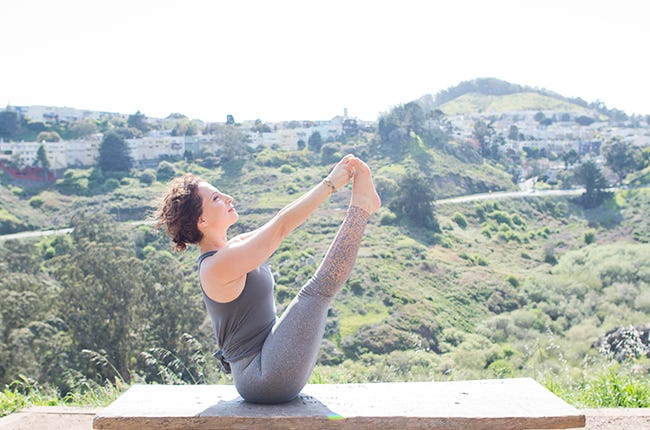This is the fifth post for our book club featuring Yoga for Bendy People by Libby Hinsley.
Be sure to register for our conversation with Libby on June 29th. The topic is: How to Design an Asana Practice for Bendy People. Reg link is at the bottom of this post. If you’re not a paid member, consider upgrading your membership to join us.
(To read previous posts, click on Yogaland Book Club in the navbar above.)
In Chapter 5: Is Yoga Bad for Bendy People?
Given that Libby devotes the second half of the book to adapting yoga practice for bendies, we can already guess that she’s not going to say that yoga is universally bad for bendies.
But there’s a reason for this chapter and it’s this: Many well-meaning people will tell bendies that they should stop doing yoga asana because it’s too risky.
This chapter reminded me that when I hobbled into an orthopedic surgeon’s office at age 29, my tender sacrum stubbornly resistant to healing after a year of searching for answers, he offered his opinion as though it was a mandate “Find another profession than teaching yoga,“ where his exact words.
Naturally, I was devastated. For precisely 24 hours. And then I realized that no sane person should advise another person to stop moving their body on the daily, especially when their discipline of choice provides so many options.
The issue, as Libby points out, is that having a lot of options can be confusing, especially when “well-meaning teachers like to claim their style of asana practice is great for everyone.” (p.93)
When there’s a mismatch [between the practice and the needs of the practitioner], it can be a recipe for pain and injury. One of the gems I have gleaned from my studies in the Viniyoga lineage is: All yoga practice is about the practitioner. It’s never about the practice. Your job as a practitioner is to learn how to make yoga good at you rather than twisting yourself around to become “good” at yoga as if it is something outside yourself that you’re striving to attain.
She goes on to suggest that a better question to ask is “What types of yoga practice are most likely to be supportive for bendy people given their unique needs?”
And this, for many folks, is where it can get tricky. Because we might associate “real yoga” with certain poses. We might feel stubborn or sad about giving up a pose category. This is natural, but Libby aptly points out two things: We have the power to create a practice that’s supportive. And also:
I don’t think yoga’s feelings will be hurt if you eliminate a problematic posture from your practice. What inherent value does a posture have on its own, especially if it causes you pain and suffering?
Chapter 6: Curiosity
In Chapter 6, Libby gives us a tangible way to cope with the “ego stuff” that can come up when we need to change our practice or give up poses: We trade the expectation mindset for a “curiosity mindset.” When we practice yoga with a curiosity mindset, we use the yoga postures as tools for discovering how the bodies feel and respond. Instead of focusing on attaining the shapes, we can focus on our inner experience by tuning into sensations.
Libby says it well here:
When we bring an inquiry mindset to practice, everything changes. Suddenly the postures aren’t the goal at all. They are simply tools to help us learn something about ourselves. (p. 103)
This idea of using asana as a tool for self-inquiry is, IMHO, what makes it endlessly fascinating and useful after decades of practice. To me, it’s what makes asana practice yoga.
There is no other physical discipline in my life where I’m not only allowed, but encouraged to check in with how I’m feeling day-to-day or moment-to-moment and to be responsive to myself.
A passage on page 104 is another favorite from this chapter:
When we start getting curious, we have a chance to learn about ourselves and understand more about what we need from our practice. Accordingly, we can shape our practice to meet our needs. Asana becomes a tool. It’s a finger trying to point at the moon; it isn’t the moon itself.
At the end of the chapter, Libby shares an anecdote from her own personal experience: At a class with a new teacher, Libby was clearly told not to use props. She ignored the sinking feeling that things weren’t going to go well and did a long hold of Supta Baddha Konasana. It took her six months to full heal from the pain that flared up afterward.
I love that she shared this anecdote. It shows that even an “expert” has a hard time going against the grain in a public setting. It shows how we — too often — we feel pressured to please our teacher.
But overriding our instincts — in yoga or anywhere else for that matter — typically never ends well, right? After that experience, Libby started telling herself, “You’re in charge of your body. All the time.”
Words. to. live. by.
Keep reading with a 7-day free trial
Subscribe to Yogaland to keep reading this post and get 7 days of free access to the full post archives.







